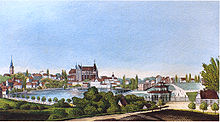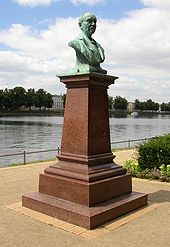Pfaffenteich
| Pfaffenteich | |
|---|---|

|
|
| 2007 view from the cathedral to the Pfaffenteich (towards northwest) | |
| Geographical location | Schwerin city center |
| Tributaries | Aubach |
| Drain | to the Ziegelsee |
| Places on the shore | Schwerin |
| Data | |
| Coordinates | 53 ° 38 '1 " N , 11 ° 24' 45" E |
| Altitude above sea level | 39.2 m above sea level NHN |
| surface | 12 ha |
| scope | 1.639 km |
| Maximum depth | 4.4 m |
| Middle deep | 2.8 m |
|
particularities |
artificially designed |

|
|
The Pfaffenteich is a pond with an area of about 12 hectares in the Schelfstadt district of the Mecklenburg-Western Pomerania state capital Schwerin .
The Aubach flows into the water on the northwest bank . The water level and discharge in the Ziegelinnensee are regulated by a weir on the north bank . The average water depth is 2.8 meters.
history

The Pfaffenteich (Low German Papendiek ) was created by the filling of a dam (later called Spieltordamm) at the north end, probably shortly after the city was founded in the 12th century, initially as a mill pond in a once boggy depression. The water originally had an extension of about 350 meters further south up to the level of Schloßstraße (Schwerin) , where the Mühlendamm bordered it to the south and a watermill that had been in use since 1178 was operated. From here the water flowed into the castle lake . A count's mill was in operation until the 19th century. At the Aubach there was a second mill, which became the property of the cathedral chapter , from then on was called Bischofsmühle and was operated until 1914. A frequent topic of dispute between the counts and the cathedral chapter, which was also able to take possession of the mill pond, was the water level. The canons, who at that time still ordered their gardens on the east bank, gave their name to the popular name “Pfaffenteich”.
The name of the northern boundary, Spieltordamm , is derived from the Central German word game , which means "pile". At that time, a row of piles protected the dam, which was accessible through a so-called play gate . The game goal, a guard and gatekeeper house, was built in 1710 and demolished in 1816. The dam was not fully expanded until 1826. The water of the Pfaffenteich once fed a moat.
Georg Adolf Demmler began straightening the Pfaffenteich bank and building on the south and west banks around 1840. The pond received its current edging and rows of linden trees . The Arsenal (south-west bank), which is now the seat of the Mecklenburg-Western Pomerania Ministry of the Interior, dates from this period . Around 1865, the first buildings were also erected on the east bank, such as a school building from 1868/70, in which the old Fridericianum was located and which was last used as a vocational school. There are plans according to which a private university of applied sciences should settle here after modernization. In the same street is the Kuetemeyersche Foundation from 1893/94, which was built according to plans by Gustav Hamann with a facade in the Johann Albrecht style and was the seat of the registry office until around 1998.
The Schliemann monument, a life-size bronze bust by the sculptor Hugo Berwald on a pedestal made of polished red granite, was unveiled in 1895 . With the construction of the gas-powered power station in the Renaissance style on the north bank of the Pfaffenteich, which was operated until 1944 and has been preserved to this day, Schwerin was supplied with electricity for the first time in 1904.
On Pentecost Sunday in 1933, a book burning took place on a floating island on the Pfaffenteich as part of the “Action against the un-German spirit” .
The plastic umbrella children created by Stephan Horota in 1973 was set up on the south bank , since the location has been changed, the sculpture is now on the southeast corner of the Pfaffenteich.
A kiosk on Schliemann-Terrasse on the east bank that still existed during the GDR era was demolished after the fall of the Wall . According to investigations, the city erected a chain-link fence around the Pfaffenteich in December 2004 due to ailing bank reinforcements, a measure that triggered a storm of indignation among the population. The banks are currently being re-paved with urban development funds and the fence has been removed. Since the bank reinforcement on the south-east bank could not be demolished for safety reasons, the bank line of this approximately 200-meter-long construction section had to be relocated about 1.50 meters into the Pfaffenteich. The renovation work on the east, south and west banks was completed in June 2009, the renovation of the north bank in October 2010.
Events are held regularly at the Pfaffenteich, such as B. dragon boat races , bicycle races , art installations and various festivals. The modernized south-facing terrace is mainly used for gastronomy in summer. A fountain is operated in the water during the summer season. A swan island with thatched accommodation has been floating on the Pfaffenteich since 1937. The current Schwanenhaus dates from the 1970s and was reconstructed in 1981, 1999 and 2010 respectively.
Ferry service
As the city expanded around the Pfaffenteich, it was quickly seen as an obstacle, which was why a certain Johann Bosselmann suggested setting up a ferry connection across the small body of water. This was realized from 1879 in rowing operation, from 1928 with motor boats. In 1955 a Spreewald ferry built in 1924 and formerly open was launched in 1955. After further modifications, this watercraft is still in operation today and was renamed " Petermännchen ", the name of the Schwerin castle spirit , on the occasion of the 100th anniversary of the connection in 1979 . Today, the ferry operated by the Schwerin local transport service calls at four stops of the passengers' choice from April to October.
Flora and fauna
Four types of mussels, six types of snails and various bird species as well as frizzy pondweed , grassy pondweed and waterweed occur in the eutrophic water . The growth of the latter is so strong that it is mowed every year with special technology under water.
See also
swell
- ↑ B. Kasten and J.-U. Rost: Schwerin. History of the city. , Schwerin 2005, ISBN 3-935749-38-4 , p. 9
- ↑ Udo Brincker: Chronology in numbers. Pastry shop in the Schlossgarten Pavilion since 1818 , Schweriner Volkszeitung, October 11, 2010
- ^ Georg Dehio: Handbook of German Art Monuments. Mecklenburg-Western Pomerania , Deutscher Kunstverlag, revision, Munich / Berlin 2000, ISBN 3-422-03081-6
- ↑ Nazi era, beginnings hartmutstein.com
- ^ Pfaffenteich in a new shine , Schweriner express, June 27, 2009, p. 1
- ↑ Pfaffenteich-Ufer in new splendor , Schweriner Volkszeitung, October 13, 2010
- ↑ Schwanenhaus in Not , Schweriner Volkszeitung, July 1, 2009, p. 15
- ↑ Schwanenhaus is back , Schweriner Volkszeitung, June 12, 2010, p. 17
- ↑ Article in the Schweriner Volkszeitung on August 15, 2007






